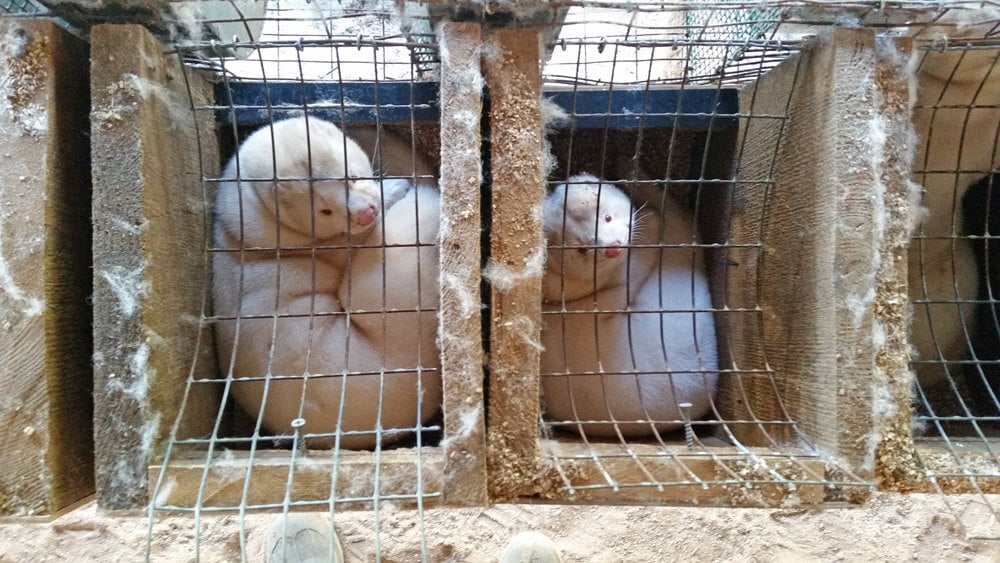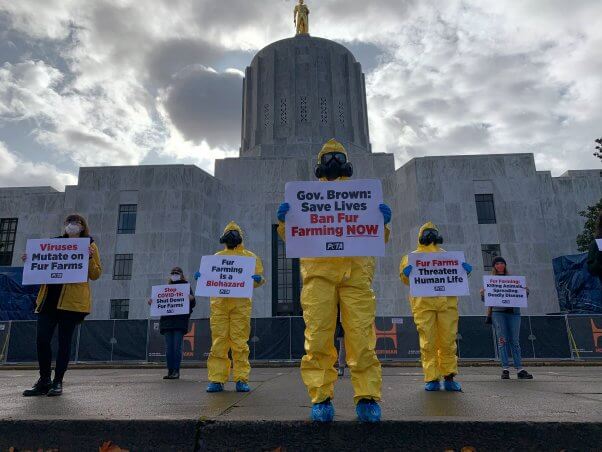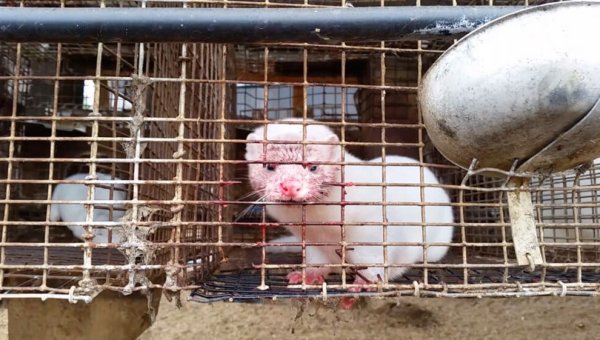COVID-19 Outbreaks Force Sweden to Ban Mink Breeding in 2021
More hope for minks, rabbits, chinchillas, and other animals used for fur! After recognizing the extremely dangerous—and potentially fatal—conditions on mink farms that have led to several outbreaks of the novel coronavirus all over the world, Sweden and Denmark both announced a temporary ban on breeding minks in 2021. Given the threat of spreading a mutated strain of COVID-19—like the one that led Denmark to slaughter 17 million minks—the breeding ban is long overdue but it is not enough.
Until the ban is permanent in Sweden and all over the world, fur farms will continue to be hotbeds for deadly diseases like COVID-19, because of the crowded, filthy conditions. Minks and other animals will continue to self-mutilate and pace endlessly in cages before farm workers electrocute or gas them to death and skin them. There is no reason to murder minks or any other animals for their fur—not now, not ever.
PETA is celebrating—but unsurprised—to hear of the imminent demise of Kopenhagen Fur, the world’s largest fur auction house, based in Denmark. Since the public and almost every major designer around the globe now shuns fur after decades of PETA campaigns, it’s only natural that yet another of the world’s biggest fur-peddling companies is collapsing. Fur is well and truly dead, but the threat posed by remaining fur farms is still very real.
The Link Between Mink Fur Farms and Contagious Diseases Like COVID-19
“Wet markets,” like the one where the novel coronavirus is believed to have originated, aren’t the only hotbeds for contagious diseases: Fur farms could also play a role in the spread of global pandemics. Pathogens flourish on these farms as well as in live-animal markets. So when it comes to the public health risks that they pose, these bloody environments are no different. As we’ve seen with numerous global health scares, deadly diseases can spread to humans in places where animals are kept in close confinement or killed.
Minks are caged and raised for slaughter on farms in Denmark, where a new, mutated strain of the virus that causes COVID-19 has already jumped from minks to humans—infecting at least 12 people—after minks caught the virus from workers. But this threat isn’t isolated to that country—minks in Greece, Italy, France, the Netherlands, Spain, Sweden, and the U.S. have tested positive, too. A mink breeder in Greece also tested positive for the same strain that minks on the farm were infected with.
In Canada, a mink farm in British Columbia announced a COVID-19 outbreak. This prompted PETA Honorary Director Pamela Anderson—a Canadian citizen—to send a letter to the premier of British Columbia, John Horgan, urging him to shut down all the fur factory farms in the province immediately.
“The world is a much different place than it was even a few months ago,” she wrote. “No one, including minks, deserves to die of COVID-19, and I hope to hear that you will make the lifesaving decision to shut down British Columbia’s mink farms without delay.”
Even in countries where coronavirus outbreaks have not been linked to fur farms yet, such as Ireland, the risk that PETA predicted months ago is still a consideration, leading for calls for minks to be killed en masse to prevent the spread of infectious diseases.
These animals should never have been put in this position in the first place. Cramming animals together in filthy conditions caused this pandemic. Until humans choose vegan materials instead of chinchilla coats, mink lashes, and rabbit fur–trimmed gloves, all our lives are at risk. That’s exactly why PETA is publicly calling on top-producing fur states, including Idaho, Minnesota, Utah, and Wisconsin, to shut down risky and cruel fur farms immediately.
What Do Animals Like Minks on Fur Farms Endure?
Animals raised for their fur—including minks, foxes, and raccoon dogs—are typically confined to cramped wire cages. Many don’t have enough room to turn around or even fully stretch out. The conditions that they’re forced to live in are filthy. As a result of severe stress, animals on fur farms resort to self-mutilation or cannibalization of their cagemates. Injured animals in the fur industry commonly receive no veterinary care.
A two-month PETA undercover investigation of Dillenburg Fur Farm, LLC, a massive facility in Wisconsin—the nation’s top mink-producing state—revealed that thousands of minks and scores of foxes were kept in rows of dirty, wire-floored cages until they were slaughtered, all so that their fur could be turned into coats and collars. Many animals were caged above foot-high piles of their own waste. In one instance, a mink chewed through a cage until her face was bloody.
Do Diseases Start on Fur Farms?
On today’s squalid fur farms, animals are confined to cramped wire cages. This allows for urine, excrement, pus, and blood to flow from one adjacent or stacked cage to another. Animals with infections, sores, and festering wounds caused by the hard wire that they’re forced to stand on are a common sight.
In these conditions, contagious diseases can easily spread among the animals or even to human workers.

In Utah, where the first cases of mink infected by the novel coronavirus were found, state authorities allegedly failed to disclose the death of a mink farm worker linked to a COVID-19 outbreak at a mink farm in the state.
According to reports, dozens of mink farms in the Netherlands raised animals who tested positive for coronavirus.
Which Diseases Start on Fur Farms?
A wide range of pathogens can infect foxes, raccoon dogs, and minks. Some of these diseases, including tularemia, hepatitis E, and influenza, are zoonotic, meaning that they can spread from animals to humans.
Hepatitis E, a viral disease, can cause swelling of the liver, jaundice, and lack of appetite in humans. Tularemia is a bacterial disease that fur handlers commonly suffer from—and just a small number of bacteria can cause potentially lethal infections.
And it’s not just the workers on fur farms who are at risk. Any industry in which humans handle animals poses a risk of animal-to-human transmission of a newly evolved virus and outbreaks of disease.
PETA Is Working to Help These Animals Right Now
After Anna Wintour, the editor of Vogue, said that the COVID-19 pandemic offered an opportunity to “re-think our values,” PETA fired off a letter urging the notorious fashion maven to scratch fur from the pages of the magazine. Stylish faux furs and other vegan fabrics are available in stores everywhere, and PETA continues to work with designers and retailers, encouraging them to use and sell only animal-friendly materials.
We’re also making an appeal to the governor of Wisconsin—the largest mink fur–producing state in the U.S., with more than 50 mink farms—calling for him to shut down these facilities immediately in an effort to protect human lives. Annually, Wisconsin produces more than 1 million mink pelts—over a third of the national total.
What You Can Do to Help
Join in our efforts to help prevent animals from being killed for fur by urging brands to stop selling it. Get started now:


